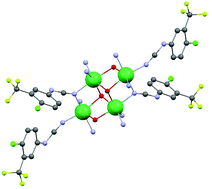The reaction of Ni(NO3)2·6H2O with di-2-pyridyl ketone, (py)2CO, and the R-phenylcyanamides 4Cl-3CF3-PhHNCN and 4F-3CF3-PhHNCN in CH3OH or CH3CH2OH allows the isolation of the tetranuclear compounds [(Ni4(μ-py2COOCH3)2(μ3-py2COOH)2(μ1,1-4Cl-3CF3-PhNCN)2(4Cl-3CF3-PhNCN)2]·CH3OH (1), [(Ni4(μ-py2COOCH2CH3)2(μ3-py2COOH)2(μ1,1-4Cl-3CF3-PhNCN)2(4Cl-3CF3-PhNCN)2]·2EtOH (2) and [(Ni4(μ-py2COOCH3)2(μ3-py2COOH)2(μ1,1-4F-3CF3-PhNCN)2(4F-3CF3-PhNCN)2]·4CH3OH (3). {(py)2C(OH)O}− and {(py)2C(OR)O}− are the monoanions of the gem-diol and hemiketal (R = CH3, CH2CH3) forms of (py)2CO. X-ray diffraction analysis reveals defective double-cubane tetrameric entities in which the Ni(II) atoms are linked by μ1,1-R-phenylcyanamido bridges and two kinds of O-bridges. The molar magnetic susceptibility measurements of 1–3 in the 2–300 K range indicate bulk ferromagnetic coupling.
